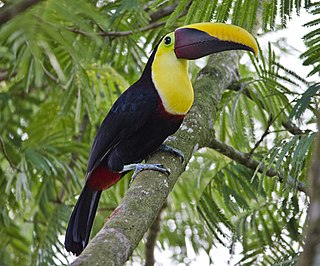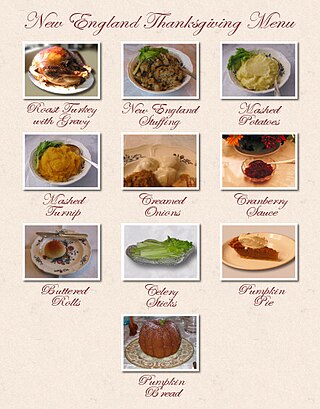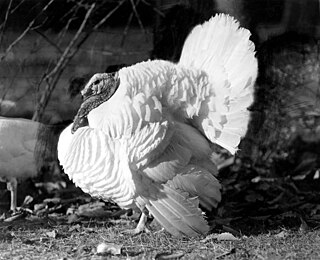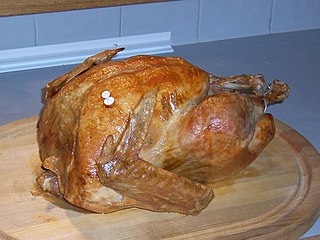
Poultry are domesticated birds kept by humans for the purpose of harvesting useful animal products such as meat, eggs or feathers, and the practice of raising poultry is known as poultry farming. These birds are most typically members of the superorder Galloanserae (fowl), especially the order Galliformes. The term also includes waterfowls of the family Anatidae and other flying birds that are kept and killed for their meat such as the young pigeons, but does not include wild birds hunted for food known as game or quarry.

The domestic turkey is a large fowl, one of the two species in the genus Meleagris and the same species as the wild turkey. Although turkey domestication was thought to have occurred in central Mesoamerica at least 2,000 years ago, recent research suggests a possible second domestication event in the area that is now the southwestern United States between 200 BC and AD 500. However, all of the main domestic turkey varieties today descend from the turkey raised in central Mexico that was subsequently imported into Europe by the Spanish in the 16th century.

The pin-tailed sandgrouse is a medium large bird in the sandgrouse family. It has a small, pigeon like head and neck and a sturdy, compact body. It has long pointed wings, which are white underneath, a long tail and a fast direct flight. Flocks fly to watering holes at dawn. The call is a loud kattar-kattar. This gregarious species breeds on dry open treeless plains and similar habitats. Its nest is a ground scrape into which two or three cream-coloured eggs with cryptic markings are laid. Both sexes incubate the eggs.

The Indian Game is a British breed of game chicken, now reared either for meat or show. It originated in the early nineteenth century in the counties of Cornwall and Devon in south-west England. It is a heavy, muscular bird with an unusually broad breast; the eggs are brown.

The Sussex is a British breed of dual-purpose chicken, reared both for its meat and for its eggs. Eight colours are recognised for both standard-sized and bantam fowl. A breed association, the Sussex Breed Club, was organised in 1903.

The Pekin or White Pekin is an American breed of domestic duck, raised primarily for meat. It derives from birds brought to the United States from China in the nineteenth century, and is now bred in many parts of the world. It is often known as the American Pekin to distinguish it from the German Pekin, a distinct and separate breed which derives from the same Chinese stock but has different breeding. Many of these ducks were reared on Long Island, New York, in the late nineteenth and early twentieth centuries, from which the breed derived its name Long Island Duck.

The chestnut-mandibled toucan or Swainson's toucan is a subspecies of the yellow-throated toucan which breeds from eastern Honduras to northern Colombia to western Ecuador.

The centerpiece of contemporary Thanksgiving in the United States and in Canada is Thanksgiving dinner, a large meal generally centered on a large roasted turkey. Thanksgiving could be considered the largest eating event in the United States as measured by retail sales of food and beverages and by estimates of individual food intake. People often consume as much as three or four thousand calories during the course of the dinner.

The National Thanksgiving Turkey Presentation is a ceremony that takes place at the White House every year shortly before Thanksgiving. The president of the United States is presented with a live domestic turkey by the National Turkey Federation (NTF), usually males of the Broad Breasted White variety. The early years also included a joint presentation with the Poultry and Egg National Board. The ceremony dates back to the 1940s; these turkeys were usually slaughtered and eaten prior to the 1970s, when it became standard practice to spare the turkey. During the Presidency of George H. W. Bush, it became a tradition for the president to issue a ceremonial "pardon" to the turkey. It is a tradition that the turkeys be picked from the chairperson of the NTF's home state, occasionally from the chair's own farm.

Chicken is the most common type of poultry in the world. Owing to the relative ease and low cost of raising chickens—in comparison to mammals such as cattle or hogs—chicken meat and chicken eggs have become prevalent in numerous cuisines.

The Rouen is a heavyweight breed of domesticated duck. Rouens are raised primarily for meat, exhibition, or as general purpose ducks. Since they are not prolific egg layers, Rouen ducks are most commonly bred for their meat. The breed originated in France sometime before the 19th century.

The Bourbon Red is an American breed of domestic turkey. It is named for its reddish-brown plumage and for its area of origin, Bourbon County, Kentucky, where it was developed in the last years of the nineteenth century. It was accepted into the Standard of Perfection of the American Poultry Association in 1909, and in the early twentieth century was an important commercial meat breed until the Broad Breasted White began to dominate industrial production. The Bourbon Red is considered a heritage turkey; it is an endangered breed, classified as 'watch' by the Livestock Conservancy. It was formerly known as the Bourbon Butternut or as the Kentucky Red.

Poultry farming is the form of animal husbandry which raises domesticated birds such as chickens, ducks, turkeys and geese to produce meat or eggs for food. Poultry – mostly chickens – are farmed in great numbers. More than 60 billion chickens are killed for consumption annually. Chickens raised for eggs are known as layers, while chickens raised for meat are called broilers.

Pilgrim geese is a breed of domestic goose. They are considered to be a relatively quiet, lightweight and medium-sized breed. The pilgrim goose is a rare and critically endangered species according to the American Livestock Breeds Conservancy (ALBC) and was officially entered into the American Poultry Association's Standard of Perfection in 1939. Generally, they can live for 15 to 25 years. In most breeds of geese, males and females are indistinguishable from one another; however, the pilgrim goose is well known for its auto-sexing trait. Males are characterised by white feathers while the females have grey. This sexual dimorphism makes pilgrim geese desirable for breeding as the sexes are easily determined. Their commercial use is primarily limited to the United States where they are bred for eggs and meat. They are known to grow relatively fast and are easy to handle.

The Java is a breed of chicken originating in the United States. Despite the breed's name, a reference to the island of Java, it was developed in the U.S. from chickens of unknown Asian extraction. It is one of the oldest American chickens, forming the basis for many other breeds, but is critically endangered today. Javas are large birds with a sturdy appearance. They are hardy, and are well-suited for both meat and egg production, especially by small-scale farms, homesteads, and backyard keepers.

A heritage turkey is one of a variety of strains of domestic turkey which retains historic characteristics that are no longer present in the majority of turkeys raised for consumption since the mid-20th century. Heritage turkeys can be differentiated from other domestic turkeys in that they are biologically capable of being raised in a manner that more closely matches the natural behavior and life cycle of wild turkeys. Heritage turkeys have a relatively long lifespan and a much slower growth rate than turkeys bred for industrial agriculture, and unlike industrially bred turkeys, can reproduce without artificial insemination.

The Bronze is a breed of domestic turkey. The name refers to its plumage, which bears an iridescent bronze-like sheen. The Bronze had been the most popular turkey throughout most of American history, but waned in popularity beginning in the mid-20th century. Later in its history, the breed was divided into two distinct types: the Broad Breasted Bronze and the Standard Bronze. A great deal of confusion exists about the difference between Standard and Broad Breasted Bronzes, or whether there is any difference at all. Collectively, the Standard and Broad Breasted varieties are simply called the Bronze turkey.

The Beltsville Small White is a modern American breed of domestic turkey. It was developed from 1934 at the Beltsville Agricultural Research Center of the United States Department of Agriculture in Beltsville, Maryland, and was named for that town and for its physical characteristics — small size and white plumage. It enjoyed a brief period of commercial success in the mid-twentieth century, but numbers then declined sharply; in the twenty-first century it is an endangered breed, and may be considered a heritage turkey breed.

Turkey meat, commonly referred to as just turkey, is the meat from turkeys, typically domesticated turkeys but also wild turkeys. It is a popular poultry dish, especially in North America and the United Kingdom, where it is traditionally consumed as part of culturally significant events such as Thanksgiving and Christmas respectively, as well as in standard cuisine.

The Midget White is a breed of domestic turkey named for its white plumage and small stature. The breed is the smallest standard variety of turkey, and with toms at roughly 13 lbs and hens 8-10 lbs, it weighs only slightly more than the largest chickens.



















